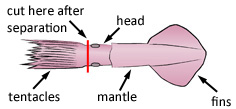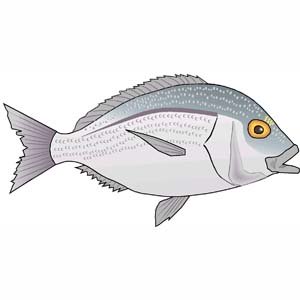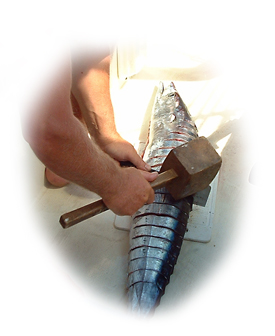- Home
- Cleaning Your Catch
- Cleaning Squid
Cleaning Squid and Other Cephalopods
Here's an easy way of cleaning squid and other cephalopods. Cephalopods? That's the generic name given to this strange group of creatures equipped with tentacles and ink.
Not only are squid, octopus and cuttlefish a primary food source of many predatory fish, but they also make a very tasty dish for we humans too.
Incidentally, in many cookery books and restaurant menus they're often referred to by their Spanish names - that's calamari (squid), sepia (cuttlefish) and pulpo (octopus, or octopi if there's more than one).
We'll tackle all three of them here, but let's make a start with cleaning squid...
Cleaning Squid
The equipment required isn't too extensive - just a sharp knife.
Lay the squid on a chopping board, grasp the mantle with one hand and the tentacles with the other, and pull gently apart. Inside the mantle you'll find the quill, which looks like a piece of plastic. But it isn't - it's pure squid - so if aboard your boat, you can throw it over the side with a clear conscience.

Then cut the head off, just behind the eyes. Keep the tentacles and the mantle and commit the rest to the deep. Remove the beak from between the tentacles, skin the mantle with your fingers and pull off the wings. Don't throw them out though, they're every bit as good as the mantle and the tentacles.
Give it all a rinse, dry it on kitchen paper or a clean cloth, and put it in the fridge until you're ready for cooking.
Incidentally, during this process you'll have come across the ink sack. If you wish you can retain this for making a sauce. Remove it carefully, being careful not to pierce it. Place it in a cup, pierce it, add a little water and pour it through a sieve. The diluted ink freezes well.
Cleaning Cuttlefish
Just like a cleaning a squid really, but to the delight of budgerigars everywhere, you'll find a cuttlebone inside instead of a quill.
Cleaning Octopus
To kill the octopus, stab it between the eyes with a pointed knife which will pierce the brain. To clean it, turn the mantle inside out and pull out all the bits you don't like the look of. If your intended pulpo menu includes the words 'con su tinto' ('with its ink' in gourmet-speak) retain the ink sac, but otherwise discard everything you find inside.
Next, remove the eyes with a sharp knife, and casting modesty aside, spread the tentacles to reveal the beak and remove that too. If you found a quill or a cuttlebone, it wasn't an octopus.
Unless you enjoy a challenge, the meat must be tenderised before cooking. You could give the beast a thorough thrashing with a wooden mallet, or just simmer it gently in water for 30 or 40 minutes. Alternatively, deep freezing the octopus and allowing it to thaw out slowly also achieves the desired result.
So with the process of cleaning squid, octopus and cuttlefish taken care of, let's take a look at one way of cooking them...
Recent Articles
-
Sea Fishing Rods and Reels Must Be Compatible for a Balanced Outfit
Mar 08, 21 08:30 AM
A quality reel fitted to a quality rod doesn't necessarily make it a quality outfit. Your fishing rods and reels have to be properly matched if you're to get the best out of them, and here’s how -
Essential Lure Fishing Tips That All Saltwater Anglers Should Know
Mar 08, 21 04:51 AM
Which single lure fishing tip applies to trolling, jigging, baitcasting, spinning, fly fishing and any other branch of lure fishing? Well, it is the one at the top of this list -
Vital Jig Fishing Tips That You Really Cannot Afford To Miss!
Mar 07, 21 10:20 AM
Essential jig fishing tips to help you select the right lure for successful jig fishing, together with the techniques required to get the most out of your jig fishing outfit





















New! Comments
Have your say about what you've just read! Leave me a comment in the box below.